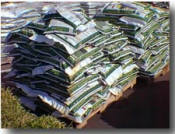
MainPage Gardening Info E-Mail Seed Catalogs Recipes S.O Equipment S.O Nurseries Gardening Questions Answered
Roses
Bareroot
Sod/Seed
Tomatoes
Zone Map West
Zone Map East
Strawberries
Insects
Pansy
Live Trees
Poinsettia
Deer
Whoa--Fertilizer, where to start. This should be one of the simplest things about gardening--but thanks to all of the makers of fertilizer--it gets real confusing. There are so many different types on the market. I will try to narrow it down for you and will try not to confuse you---but I can not promise you anything.If you have any gardening or landscape questions, please e-mail me at oregongardeningdude.com
NPK
First off- When you look at the label, you
will see three major numbers-EX-16-16-16(NPK)--The
first number stands for Nitrogen--it greens things up and gives it the growth.
The second number is Phosphorous--It helps with the strength of the plant,
flower blooms and root growth. The third
number is Potassium. This helps the plant become strong and
sturdy and helps with resistance to disease.
These three are the biggies. There are basically two types of fertilizers, as far as what to use them for--Lawn and Garden. There are alot of specialty type fertilizers out there, for example-Ferns, African Violets, Evergreens, Roses, etc. But lets stick with Lawn and Garden for now. |
Lawn Fertilizers
Spring is when you want to start fertilizing your lawn. If you fertilize too early, when the spring rains are falling, you will have a mess. The grass will be growing so fast and the rains will encourage growth. Plus it will be hard to mow your lawn. If you wait until March or April , you should be OK. You will get a temporary green up from the spring rains alone. The best Fertilizer to use is a slow release type that will last for 2 to 3 months. The number will be something like--24-7-7 or something like like. The nitrogen number will be in the 20's. If you use a weed and feed, remember--the warmer the temp-the better and do not water your lawn for two days--after you put it down. On regular fertilizer you want to water it in right away, or fertilize right before it rains. If you fertilize in March or April, then you should only have to fertilize two or three times during the growing season. In the fall, fertilize with a low nitrogen number(Winterizer) and your lawn will stay green all winter lawn(In the lower elevations of Southern Oregon). |
Garden Fertilizers
If you think that there are a lot of choices for lawn fertilizers---Start looking at all the different types of fertilizers for gardens---it can drive you crazy. Unlike lawn fert where you will have a higher nitrogen level compared to your other elements--In garden fert your three main numbers are more balanced. You will see numbers like 13-13-13 or 8-8-8. You will see a high nitrogen number in liquid ferts, but that is another subject. Most of your garden ferts do well for Vegi's, Flowers, and Shrubs. Liquid ferts work well for plants grown in containers. Granular garden ferts should last 4-6 weeks. There are a lot of good organic ferts out on the market now and their numbers will be even lower--Like a 6-2-2 or a 4-2-1. Trace minerals are very important, so try to find fertilizers that have trace minerals in it.
|